#port workers
Text
By Sharon Black
Six immigrant workers died in the bridge collapse, changing the lives of their families and communities. It’s estimated that 15,000 people work directly at the Baltimore Port, and 140,000 jobs are indirectly tied to it. All will be impacted by the shutdown.
What happened at the Key Bridge could have been expected and should have been prevented.
#Baltimore#bridge collapse#Key bridge#workers#immigrants#capitalism#disaster#port workers#Sharon Black#Struggle La Lucha
8 notes
·
View notes
Text
interesting how most of the indians who support israel are those who benefit from caste apartheid. very interesting indeed
67 notes
·
View notes
Text
"It was the IWW [Industrial Workers of the World or Wobblies] and the Finns that initially took the lead in supporting the Russian Revolution, which had profoundly influenced political developments in Finland.
...
According to A.T. Hill, local Wobblies “hailed the Russian Bolshevic [sic] revolution as something that had followed the IWW economic blueprint.” Mass meetings to protest the continued involvement of Canadian armed forces in Russia were organized. A “Friends of Russia” committee, composed of workers representing a number of organizations and trade unions in Port Arthur and Fort William, was also established. And, as Hill remembered, within the columns of the newly created Vapaus newspaper, members of the Finnish community could engage with recent events in Russia and forge closer bonds with fellow Finns working in other lumber camps.
Many Wobblies viewed the Russian Revolution in much the same way as other socialist organizations in North America. Its success was seen as an indication that the end of capitalism was at hand and that workers in North America should take heart from the events in Russia. Despite becoming largely inactive in the region during the second half of the First World War, the IWW remained vigorous across the border in Minnesota and Wisconsin. Most notably, the Superior District Lumber Workers Industrial Union No. 500 continued to agitate and to lead strikes. It was among the lumber workers in Wisconsin and Minnesota and in classes taken at the Work People’s College in Duluth, Minnesota, that Hill spent much of the war.
Drawn to the growing unrest at the Lakehead, Hill moved to Port Arthur in 1917 and dedicated himself to the activities of local Finnish socialists. On behalf of the IWW LWIU [Lumber Workers International Union], Hill and those he recruited toured much of Northwestern Ontario in an attempt to organize workers and drum up subscriptions for Vapaus. Much of the IWW’s attention was focused on the Russell and Newaygo Timber Company and its operations within the district of Thunder Bay. Despite high hopes, in the end Hill was fired (both for his agitation and for conflicts with Lutheran Finnish workers). There now existed within the camps [thanks to the Russian Revolution] a rift between non-socialists and socialists, and debates over the various interpretations of Marxism.
The IWW appealed greatly to immigrant workers in Northwestern Ontario. As Holmer Borg, a Swedish lumber worker and IWW organizer, recalled in 1972:
The IWW organized through its members. Every member was expected to organize, not necessarily by having well organized meetings, [but] simply by talking among workers.
The IWW also tended to focus on the immediate issues that faced workers where they organized. In addition, many recent immigrants were drawn to unions whose organizers actually spoke their language. Most of the other established trade unions tended to send English-speaking organizers who had little or no actual experience in the regions they were visiting or with the workers they were trying to organize.
...
One report by the Dominion Police referred to the Finns in Port Arthur as “anarchists pure and simple.”"
- Michel S. Beaulieu, Labour at the Lakehead: Ethnicity, Socialism, and Politics, 1900-35. Vancouver: University of British Columbia Press, 2011. p. 53-55.
#thunder bay#fort william#port arthur#finnish immigration to canada#industrial workers of the world#canadian socialism#northwestern ontario#russian revolution#world war 1#world war 1 canada#working class struggle#union organizing#lumber workers#pulp and paper workers#academic quote#reading 2024#labour at the lakehead
24 notes
·
View notes
Text

Railroad workers. Port Barre, Louisiana. 1938
Photo: Russell Lee
26 notes
·
View notes
Text

Port of London. Men working at the WN Sparks & Sons Wharf on the Thames . No info about the year.
Found at FB in a group abt. Old London.
17 notes
·
View notes
Note
24 sunshine and dog for the injury prompts
YES BOSS🫡prompts from here
CWs: lab/medical whump, accident in routine procedure
--
“Help them! Please!”
Had Sunshine ever heard Dog say please before?
It sounded strange, coming from him. He screamed it at the walls, at the door, at the security camera in the corner that stared down at them.
They were thankful for it, sure.
Something had gone wrong. That’s all they could tell, really. They’d been hooked in, as usual, for a flush.
But something wasn’t right. Dog saw it before they did, the port on their tailbone being tinted red as their blood swirled up into it.
There was something wrong. It hurt, and it hurt badly.
“Someone! Get in here!”
He sounded afraid.
He had every right to be. They’d just gotten out of the bandages, the scars from their emergency surgery still fresh. They didn’t want to have to go again so soon. Not when things had just gotten to the strange little semblance of normal the two of them had found.
There were more noises. Dog was saying something.
The tube was mostly a sickening pink with swirls of red, now.
There was movement from outside. Yelling, and yelling right next to them in response. It all sounded so far away.
That was the last coherent thought Sunshine had as they went down onto the ground, the port disconnecting partially as they did, unconscious before their head hit the floor.
#ask to tag#oc: sunshine#others ocs: dog#THE ouppy.#whump writing#cyberwhumper#editorial: to me. to meeee :3 the accident was caused by a newer worker not connecting the ports properly#digging into flesh which caused the bleeding#and not sealing it properly which allowed the backflow and the disconnecting when sunshine faints#this guy is getting SUPER fired#tttfd
6 notes
·
View notes
Text
im currently writing an atsugawa (I hate the name shin soukoku or whatever I'm sorry but I'm actually not. also I cannot pronounce soukoku {this is the real reason I don't use soukoku}) and I don't even ship it lmaoo
#maris bsd 🗞️#like its not a bad ship for my personal tastes#I like them alot more in trios tho I've realized#absolutely adore anytime atsu aku and kyouka are together#two disaters and a teenage girl going through the inexplicable horrors#my favorite#I also desparately wish more people saw the atsulucygawa vision.....#anyways the fic is actually more like before an establish relationship but you can read it as romantic if you want#you'd have to work extra hard though because their bickering isn't like#romantic bickering they're actually kinda getting on each others nerves#but then they have a cute moment talking about their respective agency co workers and realize they do have common ground and that's how muc#they love their lil found dysfunctional families#actually its mostly akutagawa talking Abt port mafia (IM SICK OF PPL SAYING HE DOESNT CARE ABT THEM IDC I wRITE CANON NOW TY) and atsu#realizing that akus never rlly been in a position where he could safely and openly show his affection for anyone#and the one time he did they left (dazai) (this is how the conversation starts)#(aku says smth Abt gin and atsus like “awhh you care alot :3” and akus like “no I don't” and then atsus like “ykw its okay to care Abt ppl”#and akus like “:(( but what if they leave again” and atsus like “but what if they stay?” and basically lists all the reasons why they'd sta#and then akus gets all soft and has a nice moment of caring about everyone he works with#(except maybe chuuya I cant rmb any times they've interacted and i cant think of anything fun or like core memory things they'd do together#and then aku is like “what Abt you and your family? how are they?” and then it's atsus turn to be all sappy about their family#and so then they end up having a way better day than expected AND they walked away from it with a new friend and an even better#understanding of each other and stuff#yeah#reminder I don't even ship atsugawa but wow I feel deeply abt them both.#maybe Id like them as like QPR??#I can see that alot better#but man atsulucygawa....#even they'd probably be QPR though imo#anyways pushing my “aku doesn't feel like he can allow himself to share his affection for people because he doesn't want them to leave”#agenda ty for coming to my Ted talk
2 notes
·
View notes
Text

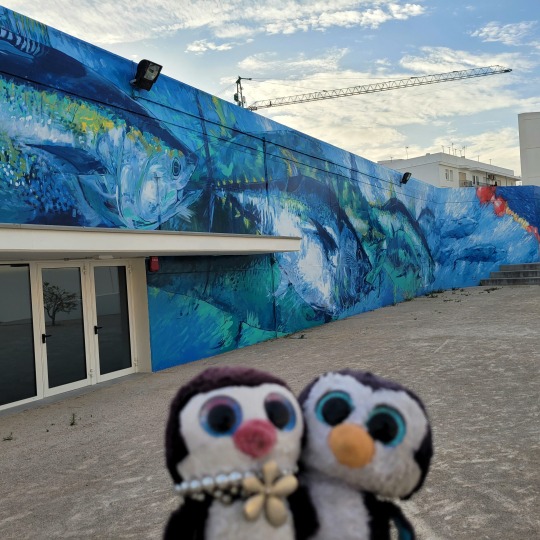
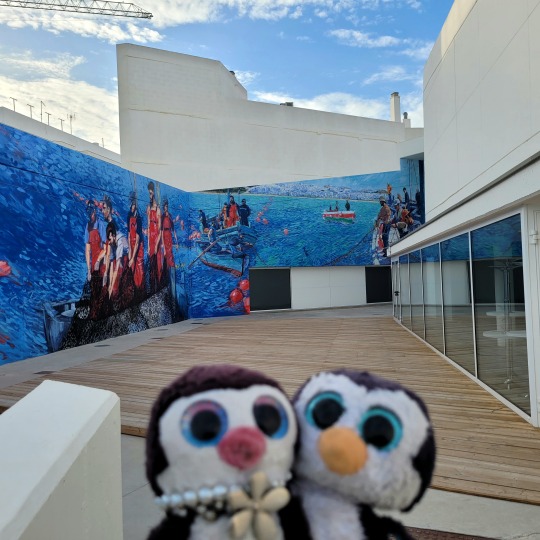
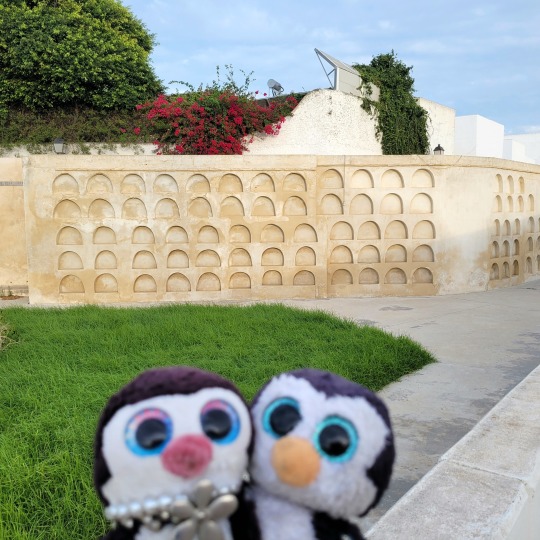

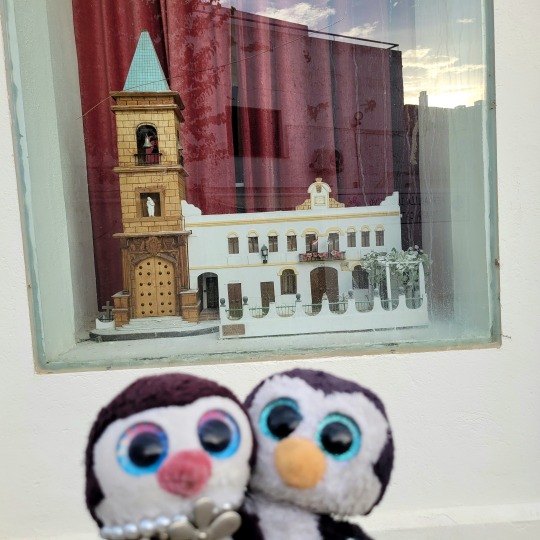
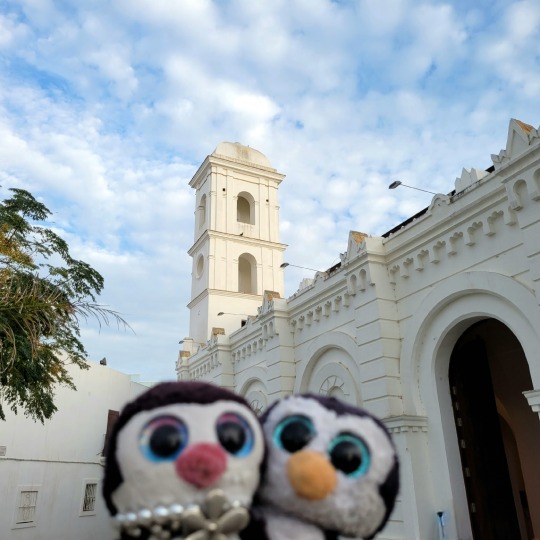
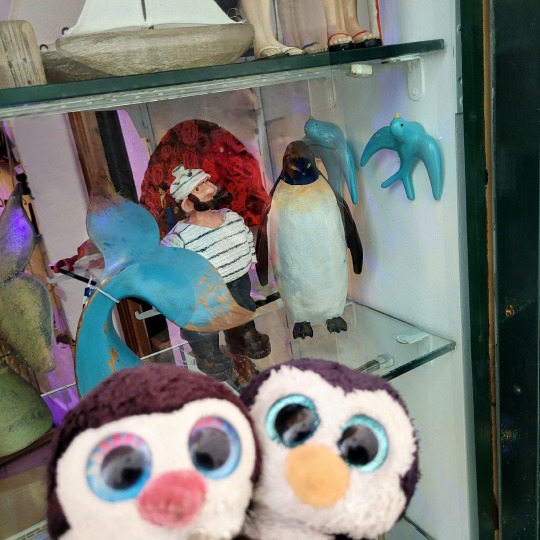
2023/10/13
En el mes de octubre aprovechamos la fiesta nacional de España para ir de viaje a un pueblo del sur de la Península. Aquí la tradición de la pesca de atún es muy fuerte, dedicando arte urbano a las personas que trabajan en el mar. Lo que parecen tumbas realmente son los lugares donde los peces se dejaban para que se secase. Tienen una bonita iglesia que ahora es un centro cultural. Y pasamos a saludar a un primo que trabaja en una tienda.
In the month of October we take advantage of the national holiday of Spain to go on a trip to a town in the south of the Peninsula. Here the tradition of tuna fishing is very strong, dedicating urban art to the people who work at sea. What look like tombs are really the places where fish were left to dry. They have a beautiful church that is now a cultural center. And we stopped by to say hello to a cousin who works in a store.
Google Translation into French:
Au mois d'octobre, nous profitons de la fête nationale espagnole pour partir en voyage dans une ville du sud de la péninsule. Ici, la tradition de la pêche au thon est très forte, consacrant l'art urbain aux personnes qui travaillent en mer. Ce qui ressemble à des tombes est en réalité l’endroit où l’on laissait sécher le poisson. Ils ont une belle église qui est maintenant un centre culturel. Et nous sommes passés dire bonjour à un cousin qui travaille dans un magasin.
Google translation into Italian:
Nel mese di ottobre approfittiamo della festa nazionale spagnola per fare un viaggio in una città del sud della penisola. Qui è molto forte la tradizione della pesca del tonno, che dedica l'arte urbana a chi lavora in mare: quelle che sembrano tombe sono in realtà luoghi dove i pesci venivano lasciati ad essiccare. Hanno una bellissima chiesa che ora è un centro culturale. E siamo passati a salutare un cugino che lavora in un negozio.
Google Translation into Portuguese:
Em outubro aproveitamos o feriado nacional espanhol para fazer uma viagem a uma cidade do sul da península. Aqui a tradição da pesca do atum é muito forte, dedicando a arte urbana às pessoas que trabalham no mar. O que parecem túmulos é na verdade onde o peixe era deixado a secar. Eles têm uma bela igreja que hoje é um centro cultural. E passamos para cumprimentar um primo que trabalha em uma loja.
Google Translation into German:
Im Oktober nutzen wir den spanischen Nationalfeiertag für einen Ausflug in eine Stadt im Süden der Halbinsel. Hier ist die Tradition des Thunfischfangs sehr stark ausgeprägt und die urbane Kunst ist den Menschen gewidmet, die auf See arbeiten. Was wie Gräber aussieht, ist in Wirklichkeit der Ort, an dem Fische zum Trocknen gelassen wurden. Sie haben eine wunderschöne Kirche, die heute ein Kulturzentrum ist. Und wir kamen vorbei, um einem Cousin Hallo zu sagen, der in einem Geschäft arbeitet.
Google Translation into Albanisch:
Në muajin tetor përfitojmë nga festa kombëtare e Spanjës për të shkuar në një udhëtim në një qytet në jug të Gadishullit. Këtu tradita e peshkimit të tonit është shumë e fortë, duke ia kushtuar artin urban njerëzve që punojnë në det. Ato që duken si varre janë në të vërtetë vendet ku peshqit liheshin të thaheshin. Ata kanë një kishë të bukur që tani është një qendër kulturore. Dhe ne u ndalëm për t'i përshëndetur një kushëriri që punon në një dyqan.
Google Translation into Arabic:
في شهر أكتوبر نستغل العطلة الوطنية لإسبانيا للذهاب في رحلة إلى بلدة في جنوب شبه الجزيرة. هنا يعتبر تقليد صيد سمك التونة قويًا جدًا، مما يكرس الفن الحضري للأشخاص الذين يعملون في البحر. ما يشبه المقابر هو في الواقع الأماكن التي تُركت فيها الأسماك لتجف. لديهم كنيسة جميلة أصبحت الآن مركزًا ثقافيًا. وتوقفنا لإلقاء التحية على ابن عم يعمل في متجر.
Google Translation into Armenian:
Հոկտեմբեր ամսին մենք օգտվում ենք Իսպանիայի ազգային տոնից՝ ճանապարհորդության գնալու թերակղզու հարավային քաղաքներից մեկում: Այստեղ թունա ձկնորսության ավանդույթը շատ ուժեղ է՝ քաղաքային արվեստը նվիրելով ծովում աշխատող մարդկանց։ Դամբարանների տեսքը իրականում այն վայրերն են, որտեղ ձկները թողնում էին չորանալու: Նրանք ունեն գեղեցիկ եկեղեցի, որն այժմ մշակութային կենտրոն է։ Եվ մենք կանգ առանք՝ բարևելու զարմիկին, ով աշխատում է խանութում։
Google Translation into Bengali:
অক্টোবর মাসে আমরা স্পেনের জাতীয় ছুটির সুযোগ নিয়ে উপদ্বীপের দক্ষিণে একটি শহরে বেড়াতে যাই। এখানে টুনা মাছ ধরার ঐতিহ্য খুবই শক্তিশালী, যারা সমুদ্রে কাজ করে তাদের শহুরে শিল্প উৎসর্গ করে। কবরগুলো দেখতে আসলেই এমন জায়গা যেখানে মাছ শুকানোর জন্য রেখে দেওয়া হয়েছিল। তাদের একটি সুন্দর গির্জা রয়েছে যা এখন একটি সাংস্কৃতিক কেন্দ্র। এবং আমরা একটি দোকানে কাজ করে এমন একজন কাজিনকে হ্যালো বলার জন্য থামলাম।
Google Translation into Bulgarian:
През месец октомври се възползваме от националния празник на Испания, за да отидем на екскурзия до град в южната част на полуострова. Тук традицията на риболова на риба тон е много силна, посвещавайки градското изкуство на хората, които работят в морето. Това, което изглежда като гробници, всъщност са местата, където рибата е била оставена да изсъхне. Те имат красива църква, която сега е културен център. И се отбихме да поздравим една братовчедка, която работи в магазин.
Google Translation into Czech:
V měsíci říjnu využíváme státního svátku Španělska k výletu do města na jihu poloostrova. Zde je tradice lovu tuňáků velmi silná a městské umění věnuje lidem, kteří pracují na moři. To, co vypadají jako hrobky, jsou ve skutečnosti místa, kde byly ryby ponechány uschnout. Mají krásný kostel, který je nyní kulturním centrem. A zastavili jsme se, abychom pozdravili bratrance, který pracuje v obchodě.
Google Translation into Simplified Chinese:
十月份我们趁着西班牙国庆假期去半岛南部的一个小镇旅行。 这里金枪鱼捕捞的传统非常浓厚,为海上工作的人们奉献了城市艺术。 看似坟墓的地方,其实是晒鱼的地方。 他们有一座美丽的教堂,现在是一个文化中心。 我们顺便向在商店工作的表弟打招呼。
Google Translation into Korean:
10월에는 스페인의 국경일을 이용하여 반도 남쪽의 한 마을로 여행을 떠납니다. 여기에서는 참치 낚시의 전통이 매우 강하여 바다에서 일하는 사람들에게 도시 예술을 바치고 있습니다. 무덤처럼 보이는 곳은 사실 물고기를 말리던 곳이다. 그들은 현재 문화 중심지가 된 아름다운 교회를 가지고 있습니다. 그리고 우리는 가게에서 일하는 사촌에게 인사를 하러 들렀습니다.
Google Translation into Croatian:
U mjesecu listopadu iskorištavamo nacionalni praznik Španjolske za odlazak na izlet u gradić na jugu Poluotoka. Ovdje je tradicija tunolova vrlo jaka, posvećujući urbanu umjetnost ljudima koji rade na moru. Ono što izgleda kao grobnice zapravo su mjesta gdje su ribe ostavljane da se suše. Imaju prekrasnu crkvu koja je danas kulturni centar. I svratili smo pozdraviti sestričnu koja radi u trgovini.
Google Translation into Danish
I oktober måned benytter vi den nationale helligdag i Spanien til at tage på tur til en by på den sydlige del af halvøen. Her er traditionen for tunfiskeri meget stærk, og dedikerer urban kunst til de mennesker, der arbejder til søs. Det, der ligner grave, er virkelig de steder, hvor fisk blev efterladt til tørre. De har en smuk kirke, der nu er et kulturelt center. Og vi kom forbi for at sige hej til en kusine, der arbejder i en butik.
Google Translation into Slovak:
V mesiaci október využívame štátny sviatok Španielska na výlet do mesta na juhu polostrova. Tradícia lovu tuniakov je tu veľmi silná a mestské umenie venuje ľuďom, ktorí pracujú na mori. To, čo vyzerajú ako hrobky, sú v skutočnosti miesta, kde sa nechali ryby vysušiť. Majú krásny kostol, ktorý je dnes kultúrnym centrom. A zastavili sme sa pozdraviť bratranca, ktorý pracuje v obchode.
Google Translation into Slovenian:
V mesecu oktobru izkoristimo državni praznik Španije za izlet v mesto na jugu polotoka. Tu je zelo močna tradicija ribolova na tune, ki urbano umetnost posveča ljudem, ki delajo na morju. Kar je videti kot grobnice, so v resnici mesta, kjer so se ribe puščale sušiti. Imajo lepo cerkev, ki je danes kulturni center. Pa sva se ustavila, da bi pozdravila sestrično, ki dela v trgovini.
Google Translation into Estonian:
Oktoobris kasutame ära Hispaania riigipüha, et minna reisile poolsaare lõunaosas asuvasse linna. Siin on tuunikalapüügi traditsioon väga tugev, pühendades linnakunsti merel töötavatele inimestele. Need, mis näevad välja nagu hauad, on tõesti kohad, kus kalad kuivama jäeti. Neil on ilus kirik, mis on praegu kultuurikeskus. Ja astusime läbi, et öelda tere nõbule, kes töötab poes.
Google Translation into Suomi:
Lokakuussa hyödynnämme Espanjan kansallista vapaapäivää lähteäksemme matkalle niemimaan eteläosassa sijaitsevaan kaupunkiin. Täällä tonnikalan kalastuksen perinne on erittäin vahva, ja se omistaa urbaanin taiteen merellä työskenteleville ihmisille. Haudat näyttävät todella paikoista, joissa kalat jätettiin kuivumaan. Heillä on kaunis kirkko, joka on nyt kulttuurikeskus. Ja pysähdyimme tervehtimään serkkua, joka työskentelee kaupassa.
Google Translation into Georgian:
ოქტომბრის თვეში ჩვენ ვიყენებთ ესპანეთის ეროვნულ დღესასწაულს, რათა ვიმოგზაუროთ ნახევარკუნძულის სამხრეთით მდებარე ქალაქში. აქ ტუნას თევზაობის ტრადიცია ძალიან ძლიერია, რომელიც ურბანულ ხელოვნებას უძღვნის ზღვაზე მომუშავე ადამიანებს. სამარხებს ჰგავს, მართლაც ის ადგილებია, სადაც თევზებს გასაშრობად ტოვებდნენ. მათ აქვთ ლამაზი ეკლესია, რომელიც ახლა კულტურული ცენტრია. და ჩვენ გავჩერდით, რომ მივესალმოთ ბიძაშვილს, რომელიც მაღაზიაში მუშაობს.
Google Translation into Greek:
Τον μήνα Οκτώβριο εκμεταλλευόμαστε την εθνική εορτή της Ισπανίας για να πάμε ένα ταξίδι σε μια πόλη στα νότια της χερσονήσου. Εδώ η παράδοση του ψαρέματος τόνου είναι πολύ έντονη, αφιερώνοντας την αστική τέχνη στους ανθρώπους που εργάζονται στη θάλασσα. Αυτά που μοιάζουν με τάφους είναι πραγματικά τα μέρη όπου τα ψάρια αφέθηκαν να στεγνώσουν. Έχουν μια όμορφη εκκλησία που είναι πλέον πολιτιστικό κέντρο. Και περάσαμε για να πούμε ένα γεια σε έναν ξάδερφο που δουλεύει σε ένα κατάστημα.
Google Translation into Guarani:
Jasy jasypokõime roaprovecha arete nacional España-pe roho haguã viaje peteî távape sur gotyo Península-pe. Ko'ápe imbareteterei tradición de pesca atún, odedikáva arte urbano umi tapicha omba'apóva mar gotyo. Umi ojoguáva sepulcro-pe ha’e añetehápe umi tenda ojeheja haguépe pira iseko haĝua. Oguereko hikuái peteî tupão iporãitereíva ha'éva ko'ágã centro cultural. Ha ropyta upépe romomaitei hag̃ua peteĩ primo ombaʼapóvape peteĩ tienda-pe.
Google Translation into Hawaiian:
I ka mahina o ʻOkakopa, hoʻohana mākou i ka lā hoʻomaha aupuni o Sepania e hele i kahi huakaʻi i ke kūlanakauhale ma ka hema o ka Peninsula. Ma ʻaneʻi, ikaika loa ke kuʻuna o ka lawaiʻa tuna, e hoʻolaʻa ana i ka hana kiʻi kūlanakauhale i ka poʻe hana ma ke kai. ʻO ke ʻano o nā lua kupapaʻu, ʻo ia nā wahi i waiho ʻia ai ka iʻa a maloʻo. He halepule nani ko lākou i kēia manawa he kikowaena moʻomeheu. A hele mākou e aloha aku i kahi hoahānau e hana ana ma kahi hale kūʻai.
Google Translation into Hebrew:
בחודש אוקטובר אנו מנצלים את החג הלאומי של ספרד כדי לצאת לטיול בעיירה בדרום חצי האי. כאן המסורת של דיג טונה חזקה מאוד, והיא מקדישה אמנות אורבנית לאנשים שעובדים בים. מה שנראה כמו קברים הם באמת המקומות שבהם הושארו דגים לייבוש. יש להם כנסייה יפה שכיום היא מרכז תרבותי. ועצרנו להגיד שלום לבן דוד שעובד בחנות.
Google Translation into Hindi:
अक्टूबर के महीने में हम स्पेन के राष्ट्रीय अवकाश का लाभ उठाकर प्रायद्वीप के दक्षिण में एक शहर की यात्रा पर जाते हैं। यहां टूना मछली पकड़ने की परंपरा बहुत मजबूत है, जो शहरी कला को समुद्र में काम करने वाले लोगों को समर्पित करती है। कब्रें जैसी दिखने वाली जगहें असल में वो जगहें हैं जहां मछलियों को सूखने के लिए छोड़ दिया जाता था। उनके पास एक खूबसूरत चर्च है जो अब एक सांस्कृतिक केंद्र है। और हम एक दुकान में काम करने वाले चचेरे भाई को नमस्ते कहने के लिए रुके।
Google Translation into Hungarian:
Október hónapban kihasználjuk Spanyolország nemzeti ünnepét, hogy kiránduljunk a félsziget déli részén található városkába. Itt nagyon erős a tonhalhalászat hagyománya, amely a városi művészetet a tengeren dolgozó embereknek szenteli. A síroknak látszó helyek valójában azok, ahol a halakat hagyták száradni. Van egy gyönyörű templomuk, amely ma kulturális központ. És megálltunk, hogy köszöntsünk egy unokatestvért, aki egy boltban dolgozik.
Google Translation into Indonesian:
Di bulan Oktober kami memanfaatkan hari libur nasional Spanyol untuk berwisata ke kota di selatan Semenanjung. Di sini tradisi penangkapan ikan tuna sangat kental, mendedikasikan seni urban untuk masyarakat yang bekerja di laut. Apa yang tampak seperti kuburan sebenarnya adalah tempat di mana ikan dibiarkan mengering. Mereka memiliki gereja indah yang sekarang menjadi pusat kebudayaan. Dan kami mampir untuk menyapa sepupu yang bekerja di toko.
Google Translation into Japanese:
10月にスペインの祝日を利用して、半島南部の町へ旅行に行きます。 ここではマグロ漁の伝統が非常に強く、海で働く人々に都市芸術を捧げています。 墓のように見えるものは、実際には魚を干した場所です。 彼らには美しい教会があり、現在は文化センターとなっています。 そして私たちは店で働いているいとこに挨拶するために立ち寄りました。
Google Translation into Kyrgyz:
Октябрь айында Испаниянын улуттук майрамынан пайдаланып, жарым аралдын түштүгүндөгү шаарга саякатка чыгабыз. Бул жерде тунец балык уулоо салты өтө күчтүү, шаардык искусствону деңизде иштеген адамдарга арнаган. Мүрзөлөр чындап эле балыктарды кургатуу үчүн калтырылган жерлер. Алардын азыр маданий борборго айланган кооз чиркөөсү бар. Ал эми дүкөндө иштеген аталаш агабызга салам айтуу үчүн токтодук.
Google Translation into Latvian:
Oktobra mēnesī mēs izmantojam Spānijas valsts svētku priekšrocības, lai dotos ceļojumā uz pilsētu pussalas dienvidos. Šeit ir ļoti spēcīgas tunzivju zvejas tradīcijas, pilsētas mākslu veltot cilvēkiem, kas strādā jūrā. Kas izskatās kā kapenes, patiešām ir tās vietas, kur zivis tika atstātas nožūt. Viņiem ir skaista baznīca, kas tagad ir kultūras centrs. Un mēs piestājām, lai pasveicinātu māsīcu, kas strādā veikalā.
Google Translation into Malayalam:
ഒക്ടോബർ മാസത്തിൽ, പെനിൻസുലയുടെ തെക്ക് ഭാഗത്തുള്ള ഒരു പട്ടണത്തിലേക്ക് ഒരു യാത്ര പോകാൻ സ്പെയിനിന്റെ ദേശീയ അവധിക്കാലം ഞങ്ങൾ പ്രയോജനപ്പെടുത്തുന്നു. ഇവിടെ ട്യൂണ മത്സ്യബന്ധനത്തിന്റെ പാരമ്പര്യം വളരെ ശക്തമാണ്, കടലിൽ ജോലി ചെയ്യുന്ന ആളുകൾക്ക് നഗര കലകൾ സമർപ്പിക്കുന്നു. ശവകുടീരങ്ങൾ പോലെ കാണപ്പെടുന്നത് മത്സ്യം ഉണങ്ങാൻ വിട്ട സ്ഥലങ്ങളാണ്. അവർക്ക് മനോഹരമായ ഒരു പള്ളിയുണ്ട്, അത് ഇപ്പോൾ ഒരു സാംസ്കാരിക കേന്ദ്രമാണ്. ഒരു കടയിൽ ജോലി ചെയ്യുന്ന ഒരു ബന്ധുവിനോട് ഹലോ പറയാൻ ഞങ്ങൾ നിർത്തി.
Google Translation into Malay:
Pada bulan Oktober kita memanfaatkan cuti kebangsaan Sepanyol untuk pergi melancong ke sebuah pekan di selatan Semenanjung. Di sini tradisi memancing tuna sangat kuat, mendedikasikan seni bandar kepada orang-orang yang bekerja di laut. Apa yang kelihatan seperti kubur sebenarnya adalah tempat di mana ikan dibiarkan kering. Mereka mempunyai sebuah gereja yang indah yang kini menjadi pusat kebudayaan. Dan kami singgah untuk bertanya khabar kepada sepupu yang bekerja di kedai.
Google Translation into Malagasy:
Amin'ny volana Oktobra dia manararaotra ny fetim-pirenen'i Espaina mba handehanana any amin'ny tanàna iray any atsimon'ny Saikinosy. Eto dia tena matanjaka ny fomban-drazana amin'ny fanjonoana tonelina, manokan-tena ho an'ny olona miasa an-dranomasina. Ny sahala amin'ny fasana no tena toerana namela ny trondro ho maina. Manana fiangonana tsara tarehy izy ireo izay foibe ara-kolontsaina ankehitriny. Ary nijanona teo izahay mba hiarahaba ny zanak'olo-mpiray tam-po miasa amina fivarotana iray.
Google Translation into Mongolian:
10-р сард бид Испанийн үндэсний баярыг ашиглан хойгийн өмнөд хэсэгт байрлах хот руу аялах гэж байна. Энд туна загас барих уламжлал маш хүчтэй бөгөөд хотын урлагийг далайд ажилладаг хүмүүст зориулдаг. Булшнууд нь үнэхээр загасыг хатааж орхисон газар юм. Тэд одоо соёлын төв болсон сайхан сүмтэй. Тэгээд бид дэлгүүрт ажилладаг үеэл ахтай мэндчилгээ дэвшүүлэн зогсов.
Google Translation into Dutch:
In de maand oktober maken we gebruik van de nationale feestdag van Spanje om op reis te gaan naar een stad in het zuiden van het schiereiland. Hier is de traditie van de tonijnvisserij erg sterk, waarbij stedelijke kunst wordt opgedragen aan de mensen die op zee werken. Wat op tombes lijkt, zijn in werkelijkheid de plaatsen waar vissen te drogen werden gelaten. Ze hebben een prachtige kerk die nu een cultureel centrum is. En we kwamen langs om hallo te zeggen tegen een neef die in een winkel werkt.
Google Translation into Nepali:
अक्टोबर महिनामा हामी प्रायद्वीपको दक्षिणमा रहेको सहरको यात्रामा जान स्पेनको राष्ट्रिय छुट्टीको फाइदा उठाउँछौं। यहाँ टुना माछा मार्ने परम्परा धेरै बलियो छ, समुद्रमा काम गर्ने मानिसहरूलाई शहरी कला समर्पित गर्दछ। चिहानहरू कस्तो देखिन्छ वास्तवमा माछा सुकाउन छोडिएको ठाउँहरू हुन्। तिनीहरूसँग एउटा सुन्दर चर्च छ जुन अहिले सांस्कृतिक केन्द्र हो। र हामी पसलमा काम गर्ने चचेरे भाईलाई नमस्कार भन्न रोक्यौं।
Google Translation into Norwegian:
I oktober måned drar vi nytte av den nasjonale høytiden i Spania til å dra på tur til en by sør på halvøya. Her er tradisjonen med tunfiskfiske veldig sterk, og dedikerer urban kunst til menneskene som jobber til sjøs. Det som ser ut som graver er egentlig stedene hvor fisken ble liggende til tørk. De har en vakker kirke som nå er et kultursenter. Og vi var innom for å hilse på en fetter som jobber i butikk.
Google Translation into Panjabi:
ਅਕਤੂਬਰ ਦੇ ਮਹੀਨੇ ਵਿੱਚ ਅਸੀਂ ਪ੍ਰਾਇਦੀਪ ਦੇ ਦੱਖਣ ਵਿੱਚ ਇੱਕ ਸ਼ਹਿਰ ਦੀ ਯਾਤਰਾ 'ਤੇ ਜਾਣ ਲਈ ਸਪੇਨ ਦੀ ਰਾਸ਼ਟਰੀ ਛੁੱਟੀ ਦਾ ਫਾਇਦਾ ਉਠਾਉਂਦੇ ਹਾਂ। ਇੱਥੇ ਟੂਨਾ ਮੱਛੀ ਫੜਨ ਦੀ ਪਰੰਪਰਾ ਬਹੁਤ ਮਜ਼ਬੂਤ ਹੈ, ਜੋ ਸਮੁੰਦਰੀ ਕੰਮ ਕਰਨ ਵਾਲੇ ਲੋਕਾਂ ਨੂੰ ਸ਼ਹਿਰੀ ਕਲਾ ਸਮਰਪਿਤ ਕਰਦੀ ਹੈ। ਕਬਰਾਂ ਵਰਗੀਆਂ ਦਿਸਦੀਆਂ ਹਨ ਅਸਲ ਵਿੱਚ ਉਹ ਸਥਾਨ ਹਨ ਜਿੱਥੇ ਮੱਛੀਆਂ ਨੂੰ ਸੁੱਕਣ ਲਈ ਛੱਡ ਦਿੱਤਾ ਗਿਆ ਸੀ। ਉਨ੍ਹਾਂ ਕੋਲ ਇੱਕ ਸੁੰਦਰ ਚਰਚ ਹੈ ਜੋ ਹੁਣ ਇੱਕ ਸੱਭਿਆਚਾਰਕ ਕੇਂਦਰ ਹੈ। ਅਤੇ ਅਸੀਂ ਇੱਕ ਚਚੇਰੇ ਭਰਾ ਨੂੰ ਹੈਲੋ ਕਹਿਣ ਲਈ ਰੁਕ ਗਏ ਜੋ ਇੱਕ ਸਟੋਰ ਵਿੱਚ ਕੰਮ ਕਰਦਾ ਹੈ।
Google Translation into Pashtun:
د اکتوبر په میاشت کې موږ د اسپانیا د ملي رخصتۍ څخه ګټه پورته کوو ترڅو د ټاپووزمې په سویل کې یو ښار ته سفر وکړو. دلته د تونا کب نیولو دود خورا پیاوړی دی، ښاري هنر هغو خلکو ته وقف کوي چې په سمندر کې کار کوي. هغه څه چې د قبرونو په څیر ښکاري واقعیا هغه ځایونه دي چیرې چې کبونه وچیدو ته پریښودل شوي. دوی یوه ښکلې کلیسا لري چې اوس یو کلتوري مرکز دی. او موږ د تره زوی ته چې په پلورنځي کې کار کوي سلام ووایو.
Google Translation into Persian:
در ماه اکتبر از تعطیلات ملی اسپانیا برای سفر به شهری در جنوب شبه جزیره استفاده می کنیم. در اینجا سنت ماهیگیری ماهی تن بسیار قوی است و هنر شهری را به افرادی که در دریا کار می کنند اختصاص می دهد. آنچه شبیه مقبره به نظر می رسد، در واقع مکان هایی است که ماهی ها را برای خشک کردن رها می کردند. آنها یک کلیسای زیبا دارند که اکنون یک مرکز فرهنگی است. و ما ایستادیم تا به پسر عمویی که در یک فروشگاه کار می کند سلام کنیم.
Google Translation into Polish:
W październiku, korzystając ze święta narodowego Hiszpanii, wybieramy się na wycieczkę do miasteczka na południu półwyspu. Tutaj tradycja połowów tuńczyka jest bardzo silna, poświęcając sztukę miejską ludziom pracującym na morzu. To, co wygląda jak grobowce, tak naprawdę jest miejscem, w którym pozostawia się ryby do wyschnięcia. Mają piękny kościół, który jest obecnie centrum kulturalnym. Zatrzymaliśmy się, żeby przywitać się z kuzynką, która pracuje w sklepie.
Google Translation into Romanian:
În luna octombrie profităm de sărbătoarea națională a Spaniei pentru a pleca într-o excursie într-un oraș din sudul Peninsulei. Aici tradiția pescuitului tonului este foarte puternică, dedicând arta urbană oamenilor care lucrează pe mare. Ceea ce arata ca morminte sunt cu adevarat locurile in care pestii au fost lasati sa se usuce. Au o biserică frumoasă care acum este un centru cultural. Și ne-am oprit să salutăm un văr care lucrează într-un magazin.
Google Translation into Russian:
В октябре мы воспользуемся национальным праздником Испании и отправимся в путешествие в город на юге полуострова. Здесь очень сильна традиция ловли тунца, посвящающая городское искусство людям, работающим в море. То, что похоже на могилы, на самом деле является местом, где рыбу оставляли сушиться. У них есть красивая церковь, которая сейчас является культурным центром. И мы зашли поздороваться с двоюродным братом, который работает в магазине.
Google Translation into Serbian:
У октобру месецу користимо национални празник Шпаније да идемо на излет у град на југу полуострва. Овде је традиција пецања туне веома јака, посвећујући урбану уметност људима који раде на мору. Оно што личи на гробнице су заиста места на којима је риба остављена да се суши. Имају прелепу цркву која је сада културни центар. И свратили смо да се поздравимо са рођаком који ради у продавници.
Google Translation into Swedish:
I oktober månad utnyttjar vi Spaniens nationella helgdag för att åka på en resa till en stad på södra halvön. Här är traditionen med tonfiskfiske mycket stark, som tillägnar stadskonst till människorna som arbetar till sjöss. Det som ser ut som gravar är verkligen de platser där fisk lämnades att torka. De har en vacker kyrka som nu är ett kulturellt centrum. Och vi kom förbi för att hälsa till en kusin som jobbar i en butik.
Google Translation into Sundanese:
Dina bulan Oktober urang ngamangpaatkeun libur nasional Spanyol pikeun indit dina lalampahan ka kota di kiduleun Semenanjung. Di dieu tradisi mancing tuna kuat pisan, ngadedikasikeun kasenian kota pikeun jalma-jalma anu damel di laut. Anu katingalina kuburan mangrupikeun tempat-tempat dimana lauk ditinggalkeun garing. Aranjeunna gaduh garéja anu saé anu ayeuna janten pusat budaya. Sarta kami dieureunkeun ku salam ka misan anu gawéna di toko.
Google Translation into Tagalog:
Sa buwan ng Oktubre, sinasamantala namin ang pambansang holiday ng Espanya upang maglakbay sa isang bayan sa timog ng Peninsula. Dito napakalakas ng tradisyon ng pangingisda ng tuna, na naglalaan ng sining sa lungsod sa mga taong nagtatrabaho sa dagat. Kung ano ang hitsura ng mga libingan ay talagang ang mga lugar kung saan ang mga isda ay pinabayaang tuyo. Mayroon silang magandang simbahan na ngayon ay sentro ng kultura. At dumaan kami para kumustahin ang isang pinsan na nagtatrabaho sa isang tindahan.
Google Translation into Thai:
ในเดือนตุลาคม เราจะใช้ประโยชน์จากวันหยุดประจำชาติของสเปนเพื่อไปเที่ยวเมืองทางตอนใต้ของคาบสมุทร ประเพณีการจับปลาทูน่าที่นี่มีความเข้มข้นมาก โดยอุทิศศิลปะเมืองให้กับผู้คนที่ทำงานในทะเล สิ่งที่ดูเหมือนสุสานคือสถานที่ซึ่งปลาถูกปล่อยให้แห้งจริงๆ พวกเขามีโบสถ์ที่สวยงามซึ่งปัจจุบันกลายเป็นศูนย์วัฒนธรรม และเราก็แวะมาทักทายลูกพี่ลูกน้องที่ทำงานในร้านแห่ง���นึ่ง
Google Translation into Telugu:
అక్టోబర్ నెలలో మేము ద్వీపకల్పానికి దక్షిణాన ఉన్న పట్టణానికి విహారయాత్రకు వెళ్లడానికి స్పెయిన్ జాతీయ సెలవుదినాన్ని సద్వినియోగం చేసుకుంటాము. ఇక్కడ ట్యూనా ఫిషింగ్ సంప్రదాయం చాలా బలంగా ఉంది, సముద్రంలో పనిచేసే ప్రజలకు పట్టణ కళను అంకితం చేస్తుంది. సమాధుల లాగా కనిపించేవి నిజంగా చేపలను ఎండబెట్టడానికి వదిలివేయబడిన ప్రదేశాలు. వారికి అందమైన చర్చి ఉంది, అది ఇప్పుడు సాంస్కృతిక కేంద్రంగా ఉంది. మరియు మేము ఒక దుకాణంలో పనిచేసే బంధువుకి హలో చెప్పడానికి ఆగిపోయాము.
Google Translation into Turkish:
Ekim ayında İspanya'nın ulusal bayramını fırsat bilerek Yarımada'nın güneyindeki bir kasabaya geziye çıkıyoruz. Burada ton balığı avcılığı geleneği oldukça güçlü olup şehir sanatını denizde çalışan insanlara adamaktadır. Mezar gibi görünen yerler aslında balıkların kurumaya bırakıldığı yerlerdir. Artık kültür merkezi olan güzel bir kiliseleri var. Bir mağazada çalışan kuzenimize merhaba demek için uğradık.
Google Translation into Ukrainian:
У жовтні ми скористаємося національним святом Іспанії, щоб вирушити в подорож до міста на півдні півострова. Тут дуже сильна традиція лову тунця, яка присвячує міське мистецтво людям, які працюють на морі. Те, що виглядає як гробниці, насправді є місцем, де рибу залишали сушитися. У них є гарна церква, яка зараз є культурним центром. І ми зайшли, щоб привітатися з двоюрідним братом, який працює в магазині.
Google Translation into Urdu:
اکتوبر کے مہینے میں ہم اسپین کی قومی تعطیل کا فائدہ اٹھاتے ہوئے جزیرہ نما کے جنوب میں ایک قصبے کی سیر پر جاتے ہیں۔ یہاں ٹونا ماہی گیری کی روایت بہت مضبوط ہے، جو سمندر میں کام کرنے والے لوگوں کے لیے شہری فن کو وقف کرتی ہے۔ قبریں کیسی نظر آتی ہیں واقعی وہ جگہیں ہیں جہاں مچھلیوں کو سوکھنے کے لیے چھوڑ دیا گیا تھا۔ ان کے پاس ایک خوبصورت چرچ ہے جو اب ثقافتی مرکز ہے۔ اور ہم ایک دکان میں کام کرنے والے کزن کو ہیلو کہنے کے لیے رک گئے۔
Google Translation into Uzbek:
Oktyabr oyida biz Ispaniyaning milliy bayramidan foydalanib, yarim orolning janubidagi shaharchaga sayohatga boramiz. Bu erda orkinos baliq ovlash an'anasi juda kuchli bo'lib, shahar san'atini dengizda ishlaydigan odamlarga bag'ishlaydi. Qabrlarga o'xshagan narsa haqiqatan ham baliqlarni quritish uchun qoldirilgan joylardir. Ularning go'zal cherkovi bor, u hozir madaniyat markaziga aylandi. Biz esa do‘konda ishlaydigan qarindoshimiz bilan salomlashish uchun to‘xtadik.
Google Translation into Vietnamese:
Vào tháng 10, chúng tôi tận dụng ngày lễ quốc gia của Tây Ban Nha để đi du lịch đến một thị trấn ở phía nam Bán đảo. Ở đây truyền thống đánh bắt cá ngừ rất mạnh mẽ, cống hiến nghệ thuật đô thị cho những người làm nghề biển. Những gì trông giống như những ngôi mộ thực sự là nơi phơi cá. Họ có một nhà thờ xinh đẹp hiện là trung tâm văn hóa. Và chúng tôi ghé qua để chào một người anh họ làm việc trong một cửa hàng.
#ConilDeLaFrontera#Cadiz#España#Spain#Tuna#RedTuna#Port#Fishermen#UrbanArt#Graffiti#Church#History#Cousin#Worker#SayHello#PolloNegroSkyWalker#TravelBlogger#Wanderlust#CoupleGoals#GoodVibes#Plushies#instaGood#Maharashtra#ペンギン
5 notes
·
View notes
Text
do you think the port mafia has an HR department
#random worker: yo that guy stole my lunch AGAIN#chuuya: then beat the shit out of him idk#(yes i will always manage to make everything about chuuya mind your business)#bsd#port mafia
17 notes
·
View notes
Text
Man, I have such a clear image of like. The map of where one of my stories takes place, but if i even tried to put it to paper I'd fuck it up so badly
#like. there's this coastline that's kind of all juttery and stuff and it very gently dips inland down south but goes almost straight and#slightly outwards in the north and about midway along the coast in the east there's a little jut-out where there's a port#north of the port there's these steep cliff faces and down south they wear down into rolling hills and slim sandy shores#the east cape of the continent is up north just off the map by maybe 25000-27000 kilometers. west of the port there's the capital and north#of that is a small old mountain range#the capital is made up of limestone and brick buildings with 4 floors and a network of huge gears and weird pulley systems throughout. they#kind of look like they're almost leaning on each other and the further toward the edges of the town you go the more it looks like the city#home just sprouted in the middle of a storefront or an inn or something overnight#the town square is set up in the ruins of this ivory castle and taken up almost completely by stalls with colorful awnings. it has dark#cobblestone streets surrounding it and no pavements ending where the forged iron and brimstone walls of the administrative buildings'#front gardens begin or branching off further into the city down streets with pavement either side#there's a foundry on the edge of time by which most locals are employed. it has it's own dedicated train line which connects with the#station further south-east. the manors and estates outside of the city have lush forests and red brick walls closer to the residences of#workers and the nobles inhabiting the land#anyways. i'll probably workshop my beloved little steampunk city more later these are just like. notes to get down the image of it i have#in my head because it's so pretty. the stalls in the square look like colorful wild flowers from above <3#boo rambles#unrelated
4 notes
·
View notes
Photo



“Wharfie I - III”
Model: Courtney
Photo: LeFu
#portrait#commercial#fitness#male#mature#dude#beard#guy#silverfox#harbour#port#wharf#worker#blue#yellow#outdoors#pal#lefu#lefuphoto
1 note
·
View note
Text
Labor disruption coming for supply chains
Now is the time for labor unions to press ports and railways for new benefits for workers. There is a perfect storm of labor stoppages about to take place.
Thursday (that’s two days from this writing) the Teamsters Canada union (TCRC) expects to strike the CPKC railroad, one of the two largest in Canada. CPKC is also a large US and Mexico railway, and we’ve yet to see if US unions will honor a…
#Canadian National lockout#CPKC railway strike#Freight embargoes#International Longshoremen&039;s Association strike#Labor stoppages 2024#labor unions#Logistics#Panama Canal drought impact#Port of Vancouver congestion#Port strikes 2024#Railway labor disputes#Railway worker benefits#Supply Chain Disruptions#supply chains#Teamsters Canada strike#Transport logistics#US East Coast port negotiations
0 notes
Text
i wish there was a way to be like "research the TRUTH about 9/11" without sounding insane, but the older i get the more i realize i wasnt misremembering and the memory of that day has become completely sanitized as an example of american heroism in the face of terrorist aggression and not one of the most horrific systematic failures and explicit moments of sociopathy resulting in a mass maiming/cancer/unidentified remains event.
an unfathomable amount of firefighters died because, despite being given a 21 minute warning that the building would collapse from a helicopter above specifically bc the NYPD hates the fire department
after the first tower had been hit, workers in tower 2 tried to flee and were told to go back to work by security guards and port authority
1000 remains are still unidenitfied
24K notes
·
View notes
Text
"The SDPC [Social Democractic Party of Canada] at the Lakehead appears not to have been content merely to contest elections. In 1912, having recently formed a union, the mostly immigrant workers of the Canadian Northern Coal and Ore Dock Company went on strike for better wages, hours, and working conditions. Bloodshed resulted when company officials, using local police and the militia, tried to suppress the striking coal handlers. The chief of police, two constables, and two Italian strikers were wounded. Fearing a general strike, the CNR quickly acquiesced to the demands of the coal handlers.
There was much in this incident that recalled earlier labour strife at the Lakehead. A new element, however, was the growing influence of radical socialists, who were thought to have sway over the coal handlers and to have been instrumental in their inclusion in the trade union movement. Prominent among the activists were “members of the Social Democratic Party of Canada,” including the party’s organizers for Port Arthur and Fort William, the Cobalt miners’ union leader James P. McGuire and the Reverend William Madison Hicks, as well as Herbert Barker, a volunteer organizer for the AFL. In April 1912, the three men led a number of English-speaking socialists in Fort William in establishing Ontario Local 51 of the SDPC. Initial members also included W.J. Carter; an architect named Richard Lockhead; Sid Wilson, a member of the British-based Amalgamated Carpenters; and Fred Moore, owner of the printing press that printed Urry’s The Wage Earner. Significantly, most of the members appear to have been Finnish or Ukrainian.
Before the strike, members of the Fort William SDPC had spoken at meetings of the coal handlers and, in the case of Hicks, played an active role by leading a parade of workers in confronting Port Arthur mayor S.W. Ray on his way to read the Riot Act to the strikers. The meeting between the two men and the violence that ensued were coincidental, according to Morrison, as
the Social Democratic party posed no real or imagined menace to the citizens of Port Arthur … what alarmed the English-speaking community was the newly won influence of the socialists with the immigrant workers.
Supporters of the ILP [Independent Labour Party] of New Ontario such as Urry found themselves “at odds with radical socialism” as
not only had the socialists played a prominent part in the strike,
though not the riot, but they were also attempting to organize Thunder Bay’s entire waterfront.
...
Calls for Hicks’s arrest began to appear in newspapers in both cities and the surrounding countryside. On 1 August 1912, officials arrested him for his role in a “tumultuous assembly … likely to promote a breach of the public peace.” Shortly after Hicks’s arrest and conviction (although he received a suspended sentence), SDPC organizers began an active campaign to take control, or at the very least undermine, the ILP-led Trades and Labour Councils. Following the strike, they sought to stage a general strike on the waterfront and, ideally, spread it throughout both Port Arthur and Fort William. As Jean Morrison writes, however, this was “a move disparaged by the British labour men for its disregard of the law which required negotiations and conciliation preceding strikes by transportation workers.” The attempt failed and widened the rift formed during the municipal, provincial, and federal elections of 1908 and 1911 and the labour unrest earlier in 1912.
...
The SDPC was also not left untouched. In preparation for the 1913 Fort William civic election, Urry and Hicks jointly developed in opposition to the SDPC a manifesto describing the class struggle in general and the issues facing the region’s workers in particular .... On the recommendation of the Elk Lake, Porcupine, and Cobalt locals that Hicks be expelled, the matter was referred to the Fort William membership. Despite facing the possibility that its charter would be revoked, Local 51 refused to expel Hicks and launched a vigorous defence on his behalf. The convincing agitator had a coterie of true believers, who “defended him to the last ditch refusing to believe that Hicks would do anything wrong.” He also had his critics, evidently including the 400-strong Fort William branch, which, it appears, sided with the Dominion Executive and expelled Hicks.
...
With Hicks departed one highly personalized version of a response to the ambiguous legacy of Lakehead socialism. Both the ILP and the SDPC grew rapidly during 1913. The labour councils in the twin cities began to discuss unity, in the form of construction of a joint Central Labour Temple. The Finnish branch of the SDPC in Port Arthur also called out for working-class and socialist unity. Moreover, as a more tangible indication of potential unification of the socialist and labour movements, SDPC organizer Herbert Barker was elected president of the Port Arthur Trades and Labour Council in April 1913.
As so often proved to be the case, however, such incipient unity was challenged by the region’s sheer class volatility. The strike by street railway workers in May 1913 was a volcanic moment. As David Bercuson writes:
The walk-out provided a focal point for much of the hatred and bitterness that had developed between labour and its enemies in the twin cities for several years.
Rioting and violence were sparked by the CPR’s attempts to use strikebreakers. When strikers overturned a streetcar operated by strikebreakers, police arrested one of the participants and, when a crowd tried to get him out of jail, fired into the crowd, killing a bystander. Local newspapers tried to pin the violence on the socialists, who were allegedly responsible for agitating the crowd.
The railway workers belonged to the Trades and Labour Councils in both cities and, in a show of solidarity, both councils called for a general sympathy strike. These calls went unheeded and most workers returned to work after four days of protest. In response, Urry, James Booker, McGuire, Bryan, and many members of the SDPC met at the Finnish Labour Temple. They criticized the local trades and labour councils “for not being radical enough to resist the ruling of an unscrupulous upper class.” They hoped the councils would become “more radical.” Not surprisingly, the obviously inflamed right-wing media in the twin cities characterized the meeting as one of “sedition, anarchy, socialism, violence and most everything else calculated to worry orderly society and responsible government.”
It was not a critique of the Lakehead workers reserved for the mainstream press. Mayor John Oliver of Port Arthur summed up the situation well when he argued that the continued unrest in Port Arthur and Fort William was not wholly due to working conditions. Making specific mention of the strikes of 1909, 1912, and 1913, he suggested that the unrest had been the result of socialist agitators. Oliver wrote:
There is hardly a night in the week that inflammatory speeches have not been made by several agitators … something will have to be done to either remove them or check their actions.
Interestingly, Frederick Urry and J.P. McGuire were specifically named for their alleged advocacy of a general strike. McGuire was further singled out for his reputed suggestion that it would be an easy thing to cut telephone, telegraph, and electric lines."
- Michel S. Beaulieu, Labour at the Lakehead: Ethnicity, Socialism, and Politics, 1900-35. Vancouver: University of British Columbia Press, 2011. p. 37-38, 40-42
#thunder bay#fort william#port arthur#strike#freight handlers#railway workers#immigrant workers#street railways#immigration to canada#canadian socialism#anglo canadians#xenophobia in canada#finnish immigration to canada#ukrainian immigration to canada#coal handlers#northwestern ontario#reading 2024#academic quote#labour at the lakehead#working class history
4 notes
·
View notes
Text
Workers’ Compensation Lawyer In New Port Richey

If you're looking Workers’ Compensation Lawyer In New Port Richey, contact the Joe Rooth Law Firm today. Call us for a free consultation today
1 note
·
View note
Text
Automation, AI, and Supplier Trust: Striking A Raw Nerve With the Workforce?
What do you do if AI is a threat to your job?
Strikes are a problem, Michael Lamoureux!
Last year I read a post by Dawn Tiura titled “Their Last Bite Of The Apple: Why West Coast Port Workers Are Fighting For Less Automation And More Pay.” – https://bit.ly/3FTmzRW
Surprisingly, the threat of a strike was not based solely on money but on introducing new technology.
Photo by Pavel Danilyuk on Pexels.com
Even though last year’s strike was…

View On WordPress
0 notes